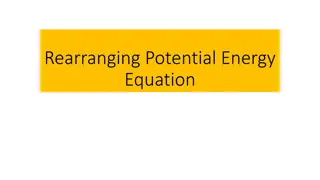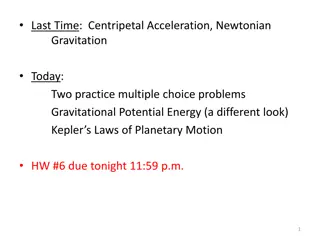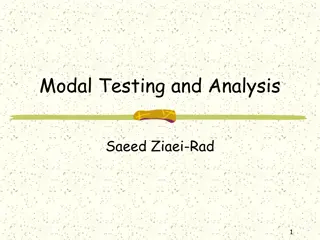Minimum Potential Energy Principle in Structural Systems
The Minimum Potential Energy (MPE) Principle in structural engineering focuses on extremizing the total potential energy to determine stable equilibrium states. It involves understanding deformations, strain energy, work potential, and equilibrium conditions in constrained structural systems. By evaluating the strain and stress distributions, one can compute the potential energy and identify the unique deformation leading to equilibrium. Emphasizing the concept of extremizing potential energy, the MPE Principle helps engineers analyze stable states and optimize structural designs.
Download Presentation

Please find below an Image/Link to download the presentation.
The content on the website is provided AS IS for your information and personal use only. It may not be sold, licensed, or shared on other websites without obtaining consent from the author.If you encounter any issues during the download, it is possible that the publisher has removed the file from their server.
You are allowed to download the files provided on this website for personal or commercial use, subject to the condition that they are used lawfully. All files are the property of their respective owners.
The content on the website is provided AS IS for your information and personal use only. It may not be sold, licensed, or shared on other websites without obtaining consent from the author.
E N D
Presentation Transcript
MPE Minimum Potential Energy Principle
MPE Principle For conservative structural systems, of all the kinematically admissible deformations, those corresponding to the extremize(i.e., minimize or maximize) the total potential energy. If the extremum is a minimum, the equilibrium state is stable. equilibrium state
MPE A constrained structural system, i.e., a structure that is fixed at some portions, will deform when forces are applied on it. Deformation of a structural system refers to the incremental change to the new deformed state from the original undeformed state. The deformation is the principal unknown in structural analysis as the strains depend upon the deformation, and the stresses are in turn dependent on the strains.
MPE Therefore, our sole objective is to determine the deformation. The deformed state a structure attains upon the application of forces is the equilibrium state of a structural system. The Potential energy (PE) of a structural system is defined as the sum of the strain energy (SE) and the work potential (WP).
MPE PE = SE +WP------------------------------1 The strain energy is the elastic energy stored in deformed structure. It is computed by integrating the strain energy density (i.e., strain energy per unit volume) over the entire volume of the structure.
MPE The work potential WP, is the negative of the work done by the external forces acting on the structure Work done by the external forces is simply the forces multiplied by the displacements at the points of application of forces.
MPE Thus, given a deformation of a structure, if we can write down the strains and stresses, we can obtain SE, WP, and finally PE. For a structure, many deformations are possible. For instance, consider the pinned-pinned beam shown in Figure 1a. It can attain many deformed states as shown in Figure 1b. But, for a given force it will only attain a unique deformation to achieve equilibrium as shown in Figure 1c.
MPE What the principle of MPE implies is that this unique deformation corresponds to the extremum value of the MPE. In other words, in order to determine the equilibrium deformation, we have to extremize the PE. The extremum can be either a minimum or a maximum. When it is a minimum, the equilibrium state is said to be stable. The other two cases are shown in Figure 2 with the help of the classic example of a rolling ball on a surface.
Application of MPE Consider the simplest model of an elastic structure viz. a mass suspended by a linear spring shown in Figure 3. We would like to find the static equilibrium position of the mass when a force F is applied. We will first use the familiar force-balance method, which gives
Application of MPE We can arrive at the same result by using the MPE principle instead of the force-balance method. Let us first write the PE for this system.
Application of MPE For the assumed values of k = 5, and F = 10, equilibrium deflection is 2 which is consistent with Figure 4. in above slide.























